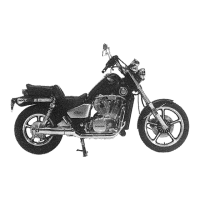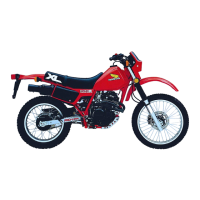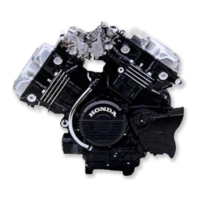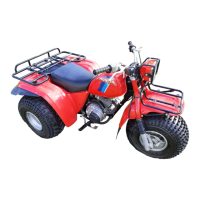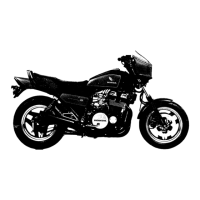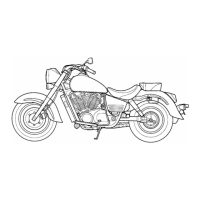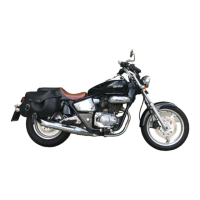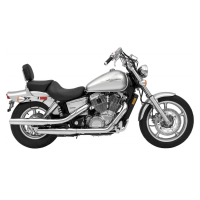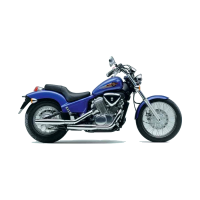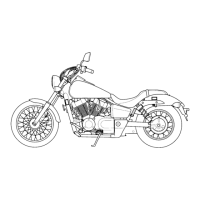Do you have a question about the Honda 1984 Shadow VT700C and is the answer not in the manual?
Safety precautions for operating and maintaining the motorcycle.
Rules for proper and safe service procedures and part usage.
Details on identifying the motorcycle's frame and engine serial numbers.
Technical specifications for dimensions, frame, and engine components of the motorcycle.
Specified torque values for various engine and chassis fasteners.
List of special and common tools required for motorcycle maintenance and repair.
Guidelines for safely routing cables and wire harnesses on the motorcycle.
Explanation of the exhaust, crankcase, and evaporative emission control systems.
General information, specifications, and service data for engine oil and final drive gear.
Details on engine oil capacity, recommendation, and viscosity.
Information on final drive gear oil capacity and recommended oil type.
Specified torque values for engine oil drain plug, filter, and pressure switch.
List of special tools for oil pressure measurement and filter wrench.
Troubleshooting guide for common issues related to engine oil level, contamination, and pressure.
General notes on engine oil, filter, and final drive gear oil.
Specifications for spark plugs and ignition timing.
Schedule detailing required maintenance items based on mileage intervals.
Steps for replacing the fuel filter as indicated by the maintenance schedule.
Checks for smooth throttle operation and adjustment of throttle grip free play.
Instructions for washing and servicing the air cleaner elements.
Recommended spark plugs, gap measurement, and replacement procedure.
Procedure for synchronizing the carburetors using vacuum gauges.
Procedure for checking engine cylinder compression pressure.
Procedures for removing, testing specific gravity, and charging the motorcycle battery.
Checks for front brake fluid reservoir level and system leaks.
Checking tire pressure, condition, tread depth, and wheel alignment.
Checking for interference with handlebar rotation and adjusting steering head bearings.
General warnings about gasoline and notes on carburetor disassembly and fuel pump inspection.
Diagnostic flow chart for engine starting, idle, and performance issues.
Step-by-step instructions for removing the fuel tank and carburetors.
Steps for removing, measuring, and adjusting the float chamber and float level.
Detailed procedure for adjusting pilot screws for idle drop in USA models.
Procedure for draining fuel from the tank and removing it.
General information, specifications, and torque values for engine removal and installation.
Step-by-step guide for removing the engine from the motorcycle frame.
Procedure for installing the engine back into the motorcycle frame.
General warnings, specifications, and troubleshooting for the cooling system.
Steps for draining, flushing, and refilling the cooling system with new coolant.
Procedure for removing, inspecting, and installing the thermostat and its housing.
Steps for removing, disassembling, inspecting, and assembling the radiator and cooling fan.
Procedures for inspecting, removing, and installing the water pump and its components.
General information, specifications, and torque values for clutch system components.
Diagnosing and resolving common clutch operation issues like lever feel, slipping, and engagement.
Procedure for draining, filling, and bleeding air from the hydraulic clutch system.
Disassembly and inspection of the clutch master cylinder components.
Disassembly and inspection of the clutch slave cylinder components.
Steps for disassembling the clutch assembly, including plates, springs, and pressure plate.
General information and specifications for the alternator and starter clutch system.
Steps for removing the flywheel, noting its left-hand threads.
Procedure for disassembling the starter clutch, including gears and needle bearing.
Steps for assembling the starter clutch and outer onto the flywheel.
Procedure for installing the flywheel onto the crankshaft, including torque specifications.
General notes on servicing the gearshift spindle and stopper arms.
Diagnosing and resolving issues with shifting hard or gears jumping out.
Step-by-step guide for removing the gearshift linkage components.
Procedure for installing the gearshift linkage components, including alignment and O-ring care.
General information on hydraulic tappets, camshaft lubrication, and head cover replacement.
Specifications for cylinder, camshaft, rocker arm, and valve measurements.
Specified torque values for cylinder head cover, bolts, and nuts.
Diagnosing engine top-end issues like low compression, excessive noise, and overheating.
Steps for removing the cylinder head covers, noting precautions for tappets.
Procedure for removing the camshaft, including timing marks and cam chain.
Procedure for adjusting hydraulic tappet shims based on assist shaft stroke measurements.
Procedure for installing the cylinder head, ensuring proper alignment and gasket sealing.
General notes on cylinder head coolant and ensuring proper gasket and O-ring placement.
Specifications for cylinder bore, piston skirt, pin hole, and clearances.
Diagnosing issues related to low compression, excessive smoke, overheating, and piston noise.
Steps for removing cylinder heads, gaskets, chain guides, and cylinders.
Procedure for inspecting cylinder bores for wear, taper, and out-of-roundness.
Measuring piston ring-to-groove clearance, end gaps, and piston skirt diameter.
Steps for installing oil jets, pistons, connecting rods, and piston pin clips.
General information on separating and assembling the crankcase.
Specified torque values for crankcase bolts, screws, and special bolts.
Steps for separating the crankcase halves, listing parts to be removed.
Procedure for assembling crankcase halves, including sealant and dowel pins.
General notes on crankcase separation, bearing selection, and torque wrench usage.
Specifications for crankshaft, connecting rod, and countershaft clearances and dimensions.
Diagnosing issues related to excessive noise, hard shifting, and output gear noise.
Steps for removing the crankshaft after separating the crankcase.
Checking crankshaft runout using dial indicators on main journals.
Inspecting connection rod bearing inserts, plastigauge measurement for oil clearance.
Steps for removing the transmission components from the left crankcase.
Checking gear dogs, holes, teeth, and bushing dimensions for wear.
Checking gear tooth contact pattern using Prussian Blue and adjusting shims.
General notes on final drive gear assembly removal and replacement of seals and O-rings.
Specifications for final gear oil capacity, recommended oil, backlash, and preload.
Specified torque values for pinion bearing retainer, nut, and gear case bolts.
Diagnosing issues related to excessive noise, oil leaks, and backlash.
Steps for removing the rear wheel, shock absorbers, and final gear case.
Procedure for separating the drive shaft from the gear case and disassembling it.
Steps for removing the ring gear, dust guard plate, and case cover.
Steps for removing the pinion joint, nut, and retainer.
Replacing gear case bearings and oil seals, including heating the case.
Installing the pinion retainer lock tab and pinion joint, and torquing the pinion nut.
Procedure for installing the dust guard plate, distance collar, and drive shaft assembly.
General information, specifications, and torque values for front wheel and suspension.
Diagnosing steering, wheel wobble, and suspension performance issues.
Procedure for removing and installing the headlight and its case.
Procedure for removing clutch master cylinder and choke cable from handlebars.
Steps for removing the front forks, including brake calipers and fender.
Checking axle runout using dial indicators.
Checking wheel bearing play and replacing noisy or worn bearings.
Removal of headlight, instruments, handlebar, and steering stem components.
General information on rear wheel, tubeless tire repairs, and riding on the rim.
Specified torque values for rear axle nut, brake link bolt, and caliper mounting bolts.
Diagnosing issues related to oscillation, soft/hard suspension, and suspension noise.
Procedure for removing the rear wheel, including axle nut and brake components.
Checking wheel bearing play and replacing noisy or worn bearings.
Inspection of brake lining thickness and disassembly/assembly of the rear brake.
Procedure for removing, disassembling, and assembling rear shock absorbers.
Steps for removing the rear wheel, final drive case, shock absorbers, and swingarm.
General information on brake calipers, fluid, and pad/disc maintenance.
Diagnosing issues with brake lever feel, grab, pull, chatter, and drag.
Procedure for draining, filling, and bleeding air from the hydraulic brake system.
Procedure for replacing brake pads, including pad pins and spring.
Disassembly and inspection of the master cylinder components.
Procedure for removing, disassembling, and inspecting brake caliper components.
General information on battery fluid level, charging, and removing the battery for charging.
Diagnosing issues related to no power, low power, intermittent power, and charging system failures.
Procedures for removing, testing specific gravity, and charging the motorcycle battery.
Procedure for testing charging system amperage at different engine speeds.
Checking stator continuity between leads and to ground.
Checking regulator/rectifier continuity between leads using an ohmmeter.
General information on the transistorized ignition system and its lack of adjustments.
Specifications for spark plugs, gap, ignition timing, and pulse air gap.
Diagnosing ignition system issues for no-start, rough running, and timing advance problems.
Procedure for removing ignition coils and testing primary and secondary coil resistance.
Pulse generator test and replacement procedures.
Replacing spark units if ignition timing is out of specification.
General information on starter motor removal with the engine in frame.
Diagnosing starter motor issues like no power, slow cranking, and engine not starting.
Steps for removing the starter motor, including covers and drive gear.
Inspecting starter motor brushes and measuring brush length and spring tension.
Inspecting commutator bars for discoloration and checking continuity.
Checking field coil continuity and resistance to the motor case.
Inspection of the starter relay switch for coil operation and continuity.
General notes on wire colors, plastic plugs, and using continuity testers for troubleshooting.
Procedure for removing, checking continuity, and installing the oil pressure switch.
Checking rear and front brake light switches for continuity when brakes are applied.
Removing and installing neutral and OD switches, including torque specifications.
Continuity tests for headlight, turn signal, and horn switches.
Checking ignition switch continuity in different positions.
Checking the operation of the low fuel warning light and its sensor.
Fabricating a test harness and checking fuel pump flow capacity.
Testing the cooling fan motor operation based on coolant temperature.
Disconnecting and checking the temperature sensor's resistance at different temperatures.
Troubleshooting and checking tachometer operation and wiring continuity.
Overview of Honda's V-twin engine, highlighting features like hydraulic tappets and off-set crankshaft.
Explanation of how the off-set crankshaft design reduces primary imbalance vibration.
Description of the hydraulic valve tappet system and its benefits for quiet operation.
Explanation of the 3-valve, 2-spark plug design for improved performance and economy.
How the one-way clutch prevents rear wheel lock-up during deceleration.
Explanation of the hydraulic tappet's operation for maintaining zero valve clearance.
Diagnostic flow chart for engine starting issues, from fuel to spark and compression.
Troubleshooting steps for diagnosing and resolving engine power loss issues.
Troubleshooting for issues affecting engine performance at low and idle speeds.
Troubleshooting steps for diagnosing poor performance at high engine speeds.
Diagnosing issues related to heavy steering, wheel wobble, and pulling to one side.
Troubleshooting noisy hydraulic tappets and engine power loss due to oil issues.
Safety precautions for operating and maintaining the motorcycle.
Rules for proper and safe service procedures and part usage.
Details on identifying the motorcycle's frame and engine serial numbers.
Technical specifications for dimensions, frame, and engine components of the motorcycle.
Specified torque values for various engine and chassis fasteners.
List of special and common tools required for motorcycle maintenance and repair.
Guidelines for safely routing cables and wire harnesses on the motorcycle.
Explanation of the exhaust, crankcase, and evaporative emission control systems.
General information, specifications, and service data for engine oil and final drive gear.
Details on engine oil capacity, recommendation, and viscosity.
Information on final drive gear oil capacity and recommended oil type.
Specified torque values for engine oil drain plug, filter, and pressure switch.
List of special tools for oil pressure measurement and filter wrench.
Troubleshooting guide for common issues related to engine oil level, contamination, and pressure.
General notes on engine oil, filter, and final drive gear oil.
Specifications for spark plugs and ignition timing.
Schedule detailing required maintenance items based on mileage intervals.
Steps for replacing the fuel filter as indicated by the maintenance schedule.
Checks for smooth throttle operation and adjustment of throttle grip free play.
Instructions for washing and servicing the air cleaner elements.
Recommended spark plugs, gap measurement, and replacement procedure.
Procedure for synchronizing the carburetors using vacuum gauges.
Procedure for checking engine cylinder compression pressure.
Procedures for removing, testing specific gravity, and charging the motorcycle battery.
Checks for front brake fluid reservoir level and system leaks.
Checking tire pressure, condition, tread depth, and wheel alignment.
Checking for interference with handlebar rotation and adjusting steering head bearings.
General warnings about gasoline and notes on carburetor disassembly and fuel pump inspection.
Diagnostic flow chart for engine starting, idle, and performance issues.
Step-by-step instructions for removing the fuel tank and carburetors.
Steps for removing, measuring, and adjusting the float chamber and float level.
Detailed procedure for adjusting pilot screws for idle drop in USA models.
Procedure for draining fuel from the tank and removing it.
General information, specifications, and torque values for engine removal and installation.
Step-by-step guide for removing the engine from the motorcycle frame.
Procedure for installing the engine back into the motorcycle frame.
General warnings, specifications, and troubleshooting for the cooling system.
Steps for draining, flushing, and refilling the cooling system with new coolant.
Procedure for removing, inspecting, and installing the thermostat and its housing.
Steps for removing, disassembling, inspecting, and assembling the radiator and cooling fan.
Procedures for inspecting, removing, and installing the water pump and its components.
General information, specifications, and torque values for clutch system components.
Diagnosing and resolving common clutch operation issues like lever feel, slipping, and engagement.
Procedure for draining, filling, and bleeding air from the hydraulic clutch system.
Disassembly and inspection of the clutch master cylinder components.
Disassembly and inspection of the clutch slave cylinder components.
Steps for disassembling the clutch assembly, including plates, springs, and pressure plate.
General information and specifications for the alternator and starter clutch system.
Steps for removing the flywheel, noting its left-hand threads.
Procedure for disassembling the starter clutch, including gears and needle bearing.
Steps for assembling the starter clutch and outer onto the flywheel.
Procedure for installing the flywheel onto the crankshaft, including torque specifications.
General notes on servicing the gearshift spindle and stopper arms.
Diagnosing and resolving issues with shifting hard or gears jumping out.
Step-by-step guide for removing the gearshift linkage components.
Procedure for installing the gearshift linkage components, including alignment and O-ring care.
General information on hydraulic tappets, camshaft lubrication, and head cover replacement.
Specifications for cylinder, camshaft, rocker arm, and valve measurements.
Specified torque values for cylinder head cover, bolts, and nuts.
Diagnosing engine top-end issues like low compression, excessive noise, and overheating.
Steps for removing the cylinder head covers, noting precautions for tappets.
Procedure for removing the camshaft, including timing marks and cam chain.
Procedure for adjusting hydraulic tappet shims based on assist shaft stroke measurements.
Procedure for installing the cylinder head, ensuring proper alignment and gasket sealing.
General notes on cylinder head coolant and ensuring proper gasket and O-ring placement.
Specifications for cylinder bore, piston skirt, pin hole, and clearances.
Diagnosing issues related to low compression, excessive smoke, overheating, and piston noise.
Steps for removing cylinder heads, gaskets, chain guides, and cylinders.
Procedure for inspecting cylinder bores for wear, taper, and out-of-roundness.
Measuring piston ring-to-groove clearance, end gaps, and piston skirt diameter.
Steps for installing oil jets, pistons, connecting rods, and piston pin clips.
General information on separating and assembling the crankcase.
Specified torque values for crankcase bolts, screws, and special bolts.
Steps for separating the crankcase halves, listing parts to be removed.
Procedure for assembling crankcase halves, including sealant and dowel pins.
General notes on crankcase separation, bearing selection, and torque wrench usage.
Specifications for crankshaft, connecting rod, and countershaft clearances and dimensions.
Diagnosing issues related to excessive noise, hard shifting, and output gear noise.
Steps for removing the crankshaft after separating the crankcase.
Checking crankshaft runout using dial indicators on main journals.
Inspecting connection rod bearing inserts, plastigauge measurement for oil clearance.
Steps for removing the transmission components from the left crankcase.
Checking gear dogs, holes, teeth, and bushing dimensions for wear.
Checking gear tooth contact pattern using Prussian Blue and adjusting shims.
General notes on final drive gear assembly removal and replacement of seals and O-rings.
Specifications for final gear oil capacity, recommended oil, backlash, and preload.
Specified torque values for pinion bearing retainer, nut, and gear case bolts.
Diagnosing issues related to excessive noise, oil leaks, and backlash.
Steps for removing the rear wheel, shock absorbers, and final gear case.
Procedure for separating the drive shaft from the gear case and disassembling it.
Steps for removing the ring gear, dust guard plate, and case cover.
Steps for removing the pinion joint, nut, and retainer.
Replacing gear case bearings and oil seals, including heating the case.
Installing the pinion retainer lock tab and pinion joint, and torquing the pinion nut.
Procedure for installing the dust guard plate, distance collar, and drive shaft assembly.
General information, specifications, and torque values for front wheel and suspension.
Diagnosing steering, wheel wobble, and suspension performance issues.
Procedure for removing and installing the headlight and its case.
Procedure for removing clutch master cylinder and choke cable from handlebars.
Steps for removing the front forks, including brake calipers and fender.
Checking axle runout using dial indicators.
Checking wheel bearing play and replacing noisy or worn bearings.
Removal of headlight, instruments, handlebar, and steering stem components.
General information on rear wheel, tubeless tire repairs, and riding on the rim.
Specified torque values for rear axle nut, brake link bolt, and caliper mounting bolts.
Diagnosing issues related to oscillation, soft/hard suspension, and suspension noise.
Procedure for removing the rear wheel, including axle nut and brake components.
Checking wheel bearing play and replacing noisy or worn bearings.
Inspection of brake lining thickness and disassembly/assembly of the rear brake.
Procedure for removing, disassembling, and assembling rear shock absorbers.
Steps for removing the rear wheel, final drive case, shock absorbers, and swingarm.
General information on brake calipers, fluid, and pad/disc maintenance.
Diagnosing issues with brake lever feel, grab, pull, chatter, and drag.
Procedure for draining, filling, and bleeding air from the hydraulic brake system.
Procedure for replacing brake pads, including pad pins and spring.
Disassembly and inspection of the master cylinder components.
Procedure for removing, disassembling, and inspecting brake caliper components.
General information on battery fluid level, charging, and removing the battery for charging.
Diagnosing issues related to no power, low power, intermittent power, and charging system failures.
Procedures for removing, testing specific gravity, and charging the motorcycle battery.
Procedure for testing charging system amperage at different engine speeds.
Checking stator continuity between leads and to ground.
Checking regulator/rectifier continuity between leads using an ohmmeter.
General information on the transistorized ignition system and its lack of adjustments.
Specifications for spark plugs, gap, ignition timing, and pulse air gap.
Diagnosing ignition system issues for no-start, rough running, and timing advance problems.
Procedure for removing ignition coils and testing primary and secondary coil resistance.
Pulse generator test and replacement procedures.
Replacing spark units if ignition timing is out of specification.
General information on starter motor removal with the engine in frame.
Diagnosing starter motor issues like no power, slow cranking, and engine not starting.
Steps for removing the starter motor, including covers and drive gear.
Inspecting starter motor brushes and measuring brush length and spring tension.
Inspecting commutator bars for discoloration and checking continuity.
Checking field coil continuity and resistance to the motor case.
Inspection of the starter relay switch for coil operation and continuity.
General notes on wire colors, plastic plugs, and using continuity testers for troubleshooting.
Procedure for removing, checking continuity, and installing the oil pressure switch.
Checking rear and front brake light switches for continuity when brakes are applied.
Removing and installing neutral and OD switches, including torque specifications.
Continuity tests for headlight, turn signal, and horn switches.
Checking ignition switch continuity in different positions.
Checking the operation of the low fuel warning light and its sensor.
Fabricating a test harness and checking fuel pump flow capacity.
Testing the cooling fan motor operation based on coolant temperature.
Disconnecting and checking the temperature sensor's resistance at different temperatures.
Troubleshooting and checking tachometer operation and wiring continuity.
Overview of Honda's V-twin engine, highlighting features like hydraulic tappets and off-set crankshaft.
Explanation of how the off-set crankshaft design reduces primary imbalance vibration.
Description of the hydraulic valve tappet system and its benefits for quiet operation.
Explanation of the 3-valve, 2-spark plug design for improved performance and economy.
How the one-way clutch prevents rear wheel lock-up during deceleration.
Explanation of the hydraulic tappet's operation for maintaining zero valve clearance.
Diagnostic flow chart for engine starting issues, from fuel to spark and compression.
Troubleshooting steps for diagnosing and resolving engine power loss issues.
Troubleshooting for issues affecting engine performance at low and idle speeds.
Troubleshooting steps for diagnosing poor performance at high engine speeds.
Diagnosing issues related to heavy steering, wheel wobble, and pulling to one side.
Troubleshooting noisy hydraulic tappets and engine power loss due to oil issues.
| Ignition | CDI |
|---|---|
| Starting | Electric |
| Transmission | 6-speed |
| Final Drive | Shaft |
| Front Suspension | Telescopic fork |
| Front Brake | Single disc |
| Rear Brake | Drum |
| Front Tire | 100/90-19 |
| Rear Tire | 140/90-15 |
| Rear Suspension | Dual shocks |
| Fuel Capacity | 13 liters |
| Fuel System | 2x Keihin carburetors |
